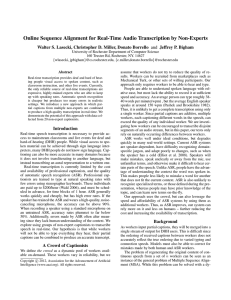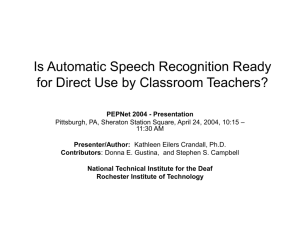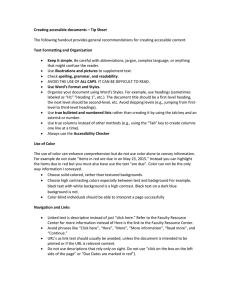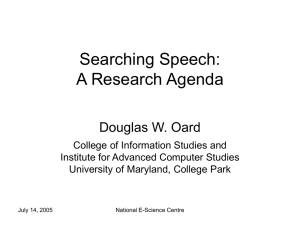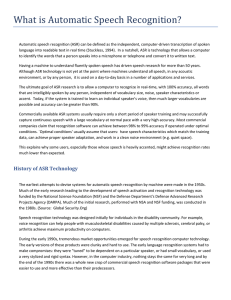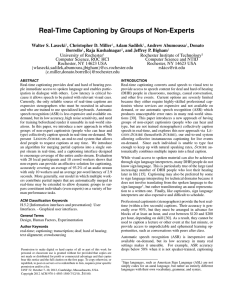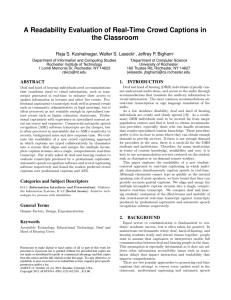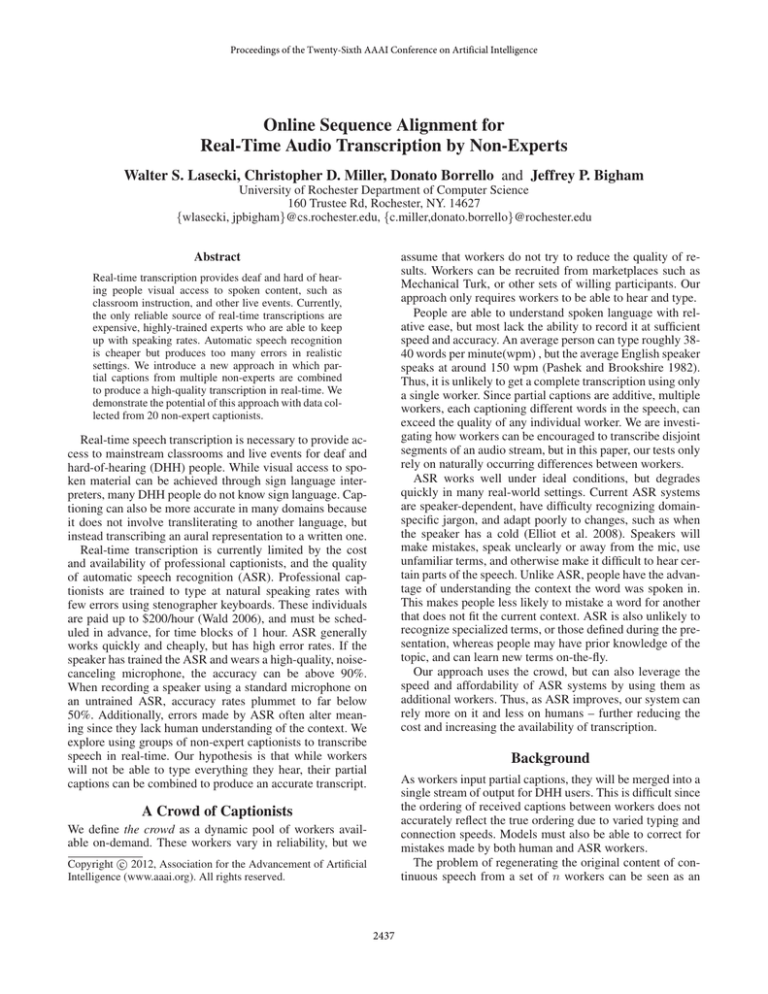
Proceedings of the Twenty-Sixth AAAI Conference on Artificial Intelligence
Online Sequence Alignment for
Real-Time Audio Transcription by Non-Experts
Walter S. Lasecki, Christopher D. Miller, Donato Borrello and Jeffrey P. Bigham
University of Rochester Department of Computer Science
160 Trustee Rd, Rochester, NY. 14627
{wlasecki, jpbigham}@cs.rochester.edu, {c.miller,donato.borrello}@rochester.edu
Abstract
assume that workers do not try to reduce the quality of results. Workers can be recruited from marketplaces such as
Mechanical Turk, or other sets of willing participants. Our
approach only requires workers to be able to hear and type.
People are able to understand spoken language with relative ease, but most lack the ability to record it at sufficient
speed and accuracy. An average person can type roughly 3840 words per minute(wpm) , but the average English speaker
speaks at around 150 wpm (Pashek and Brookshire 1982).
Thus, it is unlikely to get a complete transcription using only
a single worker. Since partial captions are additive, multiple
workers, each captioning different words in the speech, can
exceed the quality of any individual worker. We are investigating how workers can be encouraged to transcribe disjoint
segments of an audio stream, but in this paper, our tests only
rely on naturally occurring differences between workers.
ASR works well under ideal conditions, but degrades
quickly in many real-world settings. Current ASR systems
are speaker-dependent, have difficulty recognizing domainspecific jargon, and adapt poorly to changes, such as when
the speaker has a cold (Elliot et al. 2008). Speakers will
make mistakes, speak unclearly or away from the mic, use
unfamiliar terms, and otherwise make it difficult to hear certain parts of the speech. Unlike ASR, people have the advantage of understanding the context the word was spoken in.
This makes people less likely to mistake a word for another
that does not fit the current context. ASR is also unlikely to
recognize specialized terms, or those defined during the presentation, whereas people may have prior knowledge of the
topic, and can learn new terms on-the-fly.
Our approach uses the crowd, but can also leverage the
speed and affordability of ASR systems by using them as
additional workers. Thus, as ASR improves, our system can
rely more on it and less on humans – further reducing the
cost and increasing the availability of transcription.
Real-time transcription provides deaf and hard of hearing people visual access to spoken content, such as
classroom instruction, and other live events. Currently,
the only reliable source of real-time transcriptions are
expensive, highly-trained experts who are able to keep
up with speaking rates. Automatic speech recognition
is cheaper but produces too many errors in realistic
settings. We introduce a new approach in which partial captions from multiple non-experts are combined
to produce a high-quality transcription in real-time. We
demonstrate the potential of this approach with data collected from 20 non-expert captionists.
Real-time speech transcription is necessary to provide access to mainstream classrooms and live events for deaf and
hard-of-hearing (DHH) people. While visual access to spoken material can be achieved through sign language interpreters, many DHH people do not know sign language. Captioning can also be more accurate in many domains because
it does not involve transliterating to another language, but
instead transcribing an aural representation to a written one.
Real-time transcription is currently limited by the cost
and availability of professional captionists, and the quality
of automatic speech recognition (ASR). Professional captionists are trained to type at natural speaking rates with
few errors using stenographer keyboards. These individuals
are paid up to $200/hour (Wald 2006), and must be scheduled in advance, for time blocks of 1 hour. ASR generally
works quickly and cheaply, but has high error rates. If the
speaker has trained the ASR and wears a high-quality, noisecanceling microphone, the accuracy can be above 90%.
When recording a speaker using a standard microphone on
an untrained ASR, accuracy rates plummet to far below
50%. Additionally, errors made by ASR often alter meaning since they lack human understanding of the context. We
explore using groups of non-expert captionists to transcribe
speech in real-time. Our hypothesis is that while workers
will not be able to type everything they hear, their partial
captions can be combined to produce an accurate transcript.
Background
As workers input partial captions, they will be merged into a
single stream of output for DHH users. This is difficult since
the ordering of received captions between workers does not
accurately reflect the true ordering due to varied typing and
connection speeds. Models must also be able to correct for
mistakes made by both human and ASR workers.
The problem of regenerating the original content of continuous speech from a set of n workers can be seen as an
A Crowd of Captionists
We define the crowd as a dynamic pool of workers available on-demand. These workers vary in reliability, but we
c 2012, Association for the Advancement of Artificial
Copyright Intelligence (www.aaai.org). All rights reserved.
2437
instance of the general problem of Multiple Sequence Alignment (MSA). While this problem can be solved with a dynamic programming algorithm, the time and space complexity is exponential in the number and length of sequences being combined (n workers submitting k words in our case).
This complexity means that existing MSA algorithms alone
are unlikely to be able to solve this problem in real-time.
MSA also cannot align ambiguously ordered words, thus requires a level of coverage that eliminates uncertainty.
Real-time Input Combiner
Figure 1: Average coverage for groups of 1-10 workers on
four different classroom audio clips. ASR averaged 17.99%
We present a dependency-graph model to track word ordering and remove ambiguity. The graph is composed of elements that each store a set of equivalent words. These elements track the lowest timestamp of a word and the most
common spelling. We assume that each worker will provide
captions in the correct order. When a input is received, a
lookup table is used to find the best fitting element (based
on time stamp) that occurs as a descendant of the previous
word input by the same worker. If no matching element is
found, a new element is created, the word is added, and a
link between the new element and the element containing
the last word entered by the user is added. Finally, the graph
is updated to ensure only the longest path between each pair
of elements is maintained. The graph can then use statistical data to merge the branches in the graph back together to
form the caption. To prevent unbounded growth, we prune
elements with timestamps older than 15 seconds from the
actively updating graph and write them to a permanent transcript. This graph thus allows new input to be added incrementally, with updates taking less than 2ms on average.
We analyzed worker input streams and found many submit semantically equivalent captions that inadvertently differ
from other workers. Our data showed that differences were
often the result of writing style, use of contractions , or simple misspellings. To account for this, we use a set of rules
aimed at homogenizing the input without altering meaning.
We use aspell (aspell.net) to correct misspellings, and use a
simple filter for common abbreviations and contractions.
Figure 2: Average accuracy for groups of 1-10 workers on
four different classroom audio clips. ASR averaged 43.94%
show that both the coverage and accuracy can be improved
over that of a single worker. Since our approach can filter
worker input, we can achieve higher accuracy than groups of
workers using alignment. In one example with 5 workers, we
averaged 94% accuracy compares to 86% using alignment.
Conclusion and Future Work
We demonstrated the potential for groups to outperform both
individual workers and ASR in real-time transcription in
terms of coverage and accuracy and introduced a new approach for aligning partial captions to create high-quality
transcription on-the-fly. Since coverage is bounded by the
union of the the workers’ input, we are investigating interfaces that encourage workers to each caption different parts
of the audio – improving the chances that someone will type
each word. It also may be possible to use separate crowds to
correct captions in real-time to further improve quality.
Experiments
We recruited 20 undergraduate students to act as non-expert
captionists. These students had no special training, or previous formal experience transcribing audio. We asked participants to transcribe four three-minute audio clips from
MIT OpenCourseware lectures (ocw.mit.edu). These inputs
were aligned offline with an expert-transcribed baseline using the Needleman-Wunsch dynamic sequence alignment algorithm. We compared workers with Nuance’s Dragon Dictate 2 ASR on three measures: (i) coverage, the number of
words spoken that were transcribed by some worker, (ii) accuracy, the number of words entered by workers that corresponded to a spoken word, and (iii) latency, the average time
taken for some worker to input a correct caption.
Our results show that workers can outperform ASR, and
that more workers lead to better results. The average latency
across these tasks was 3.87 seconds which we expect to be
sufficient for real-time captioning. Tests with our combiner
References
Elliot, L. B.; Stinson, M. S.; Easton, D.; and Bourgeois, J.
2008. College Students Learning With C-Print’s Education
Software and Automatic Speech Recognition. In American
Educational Research Association Annual Meeting.
Pashek, G. V., and Brookshire, R. H. 1982. Effects of rate
of speech and linguistic stress on auditory paragraph comprehension of aphasic individuals. Journal of Speech and
Hearing Research 25:377–383.
Wald, M. 2006. Creating accessible educational multimedia through editing automatic speech recognition captioning
in real time. Interactive Technology and Smart Education
3(2):131–141.
2438

